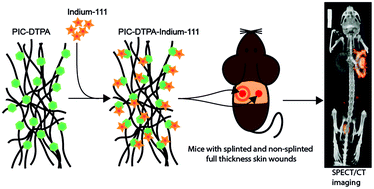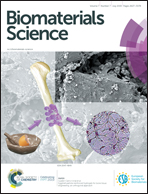Monitoring 111In-labelled polyisocyanopeptide (PIC) hydrogel wound dressings in full-thickness wounds†
Abstract
Wounds often result in scarring, prolonged morbidity, and loss of function. New interactive and modifiable hydrogel wound dressings are being developed for these injuries. Polyisocyanopeptide (PIC) gel is a promising thermosensitive hydrogel having several characteristics that can facilitate wound repair, including ease of application/removal and strain-stiffening properties that mimic extracellular matrix components. However, it is unknown whether the PIC gel remains in the wound for a clinically relevant time period. Therefore, PIC polymers were functionalized with a DTPA group allowing labelling with Indium-111 (111In). Following application of this radiolabelled gel to splinted and non-splinted murine full-thickness skin wounds the signal was monitored using SPECT/CT imaging for 7 days. The SPECT signal from the PIC gel was highly stable and covered the complete wound area. Non-bound 111In-EDTA was rapidly cleared via the kidneys to the urine. The impact of PIC gels on wound repair was further studied visually and histologically. Radiolabelled PIC gel was observed to move both over and under the skin, while histological analysis demonstrated that part of the gel became encapsulated within the wound repair tissue, but did not delay wound closure or otherwise impair wound healing. This work illustrates for the first time the use of 111In-labelled PIC gels for diagnostic and monitoring purposes and describes the use of PIC in the (non-)splinted murine skin wound model. It was found that PIC gels remained in splinted and non-splinted full-thickness skin wounds during wound repair. This warrants the continuation of developing the PIC gel into a clinically advanced wound dressing.



 Please wait while we load your content...
Please wait while we load your content...